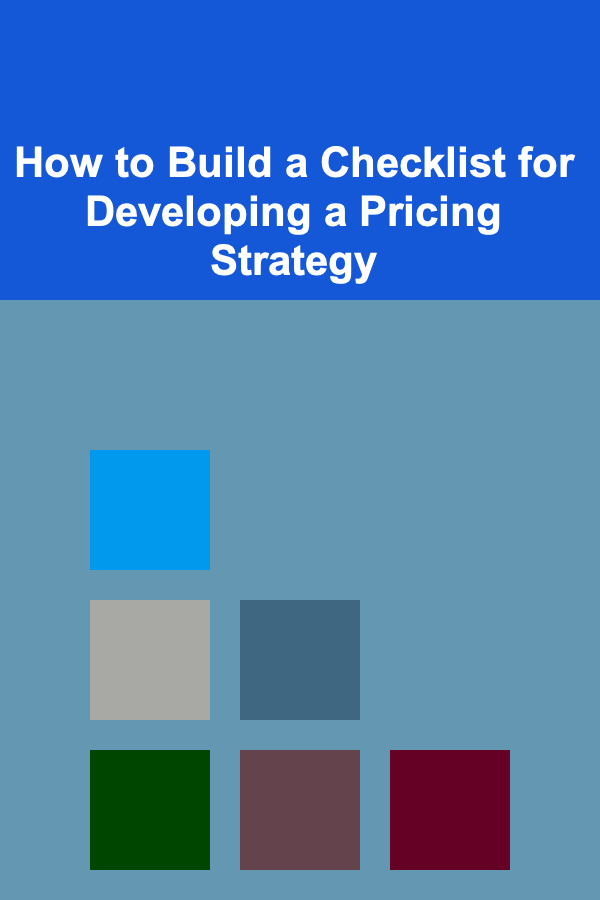
How to Build a Checklist for Developing a Pricing Strategy
ebook include PDF & Audio bundle (Micro Guide)
$12.99$11.99
Limited Time Offer! Order within the next:

Pricing is one of the most crucial aspects of any business. Whether you're running a small eCommerce store, a B2B company, or a service-based business, the right pricing strategy can make or break your success. A well-developed pricing strategy can not only help you maximize profits but also build a competitive edge, attract the right customers, and ensure long-term sustainability.
However, pricing decisions are rarely straightforward. They involve multiple factors, including market conditions, customer behavior, and business goals. Developing a structured pricing strategy requires a thoughtful approach, and having a checklist can help streamline the process and ensure you cover all the necessary elements.
This guide will provide you with a comprehensive checklist to help you develop a pricing strategy that aligns with your business goals, appeals to your target market, and stands out in a competitive marketplace.
Understand Your Business Objectives
Before diving into numbers and pricing models, it's essential to define your overall business goals. The pricing strategy you choose must be aligned with these objectives. Here are a few critical considerations:
- Profit Maximization: Are you aiming to achieve the highest possible profit margins? If so, you might lean towards premium pricing or value-based pricing.
- Market Penetration: If your goal is to gain a significant market share quickly, you may consider a penetration pricing strategy, where you set a low price to attract more customers.
- Brand Positioning: Do you want to position your brand as a luxury or budget-friendly option? Your pricing should reflect the brand identity you want to build.
- Revenue Growth: Are you focused on scaling and growth? In this case, a pricing model that promotes recurring revenue (like subscription-based pricing) could be more beneficial.
Checklist Items:
- Define your primary business goals.
- Determine how pricing can support your growth strategy.
- Consider how pricing impacts your brand perception.
Analyze the Market and Competitors
A thorough market analysis is a critical step in building a successful pricing strategy. This involves understanding the competitive landscape, customer demand, and the economic conditions of your target market.
- Competitor Pricing: Research your competitors' pricing models to identify industry standards and determine where you want to position yourself. Are your competitors offering lower prices with a focus on value, or are they using premium pricing strategies to indicate high quality?
- Market Trends: Keep an eye on market trends, including shifts in consumer preferences, purchasing power, and economic conditions. These can influence how much customers are willing to pay.
- Customer Willingness to Pay: Conduct surveys, focus groups, or interviews to gauge your target market's price sensitivity. Understanding the pain points and purchasing behavior of your ideal customers can help you set a price that resonates with them.
Checklist Items:
- Identify your main competitors and analyze their pricing strategies.
- Understand your customers' willingness to pay through market research.
- Identify any market trends or shifts that may impact pricing.
Determine Your Costs and Margins
Understanding your costs is fundamental when developing your pricing strategy. You need to ensure that your prices not only cover your expenses but also allow you to make a reasonable profit.
- Fixed and Variable Costs: Break down your costs into fixed (e.g., rent, salaries) and variable (e.g., raw materials, shipping) costs. Your pricing should cover both types of costs.
- Break-Even Point: Calculate the point at which your revenue equals your expenses, and determine how many units of your product or service need to be sold at different price points to cover costs and generate profit.
- Profit Margins: Establish desired profit margins based on your business model and industry norms. This will guide you in setting a price that achieves your financial goals.
Checklist Items:
- List all fixed and variable costs associated with your product or service.
- Calculate the break-even point for your pricing.
- Set your target profit margins based on industry standards.
Choose a Pricing Model
The pricing model you select will significantly influence how your business generates revenue and how customers perceive your products or services. There are several common pricing models to consider, depending on your industry and goals.
- Cost-Plus Pricing: A straightforward model where you mark up the cost of producing a product by a fixed percentage to determine the price.
- Value-Based Pricing: In this model, you price your product based on the perceived value to the customer, rather than the cost to produce it.
- Penetration Pricing: Offering lower prices initially to attract customers and gain market share, with the intention of increasing prices later.
- Skimming Pricing: Setting high prices initially and then gradually lowering them over time, often used for innovative or new products.
- Subscription Pricing: Charging customers a recurring fee, typically used for services or products delivered over a period of time (e.g., SaaS, memberships).
- Freemium Pricing: Offering a basic service for free while charging for premium features or upgrades.
Checklist Items:
- Choose the most suitable pricing model for your business type.
- Ensure the model supports your revenue goals and market positioning.
- Consider how the pricing model aligns with customer expectations.
Test and Iterate Your Pricing
Pricing is not a set-it-and-forget-it process. As your business grows and the market changes, you need to continuously evaluate and adjust your pricing strategy. Testing different pricing strategies and models can provide valuable insights into what works best for your business.
- A/B Testing: Test different price points and evaluate their impact on conversions, sales, and customer behavior. A/B testing can help you find the optimal price for your product or service.
- Price Elasticity: Experiment with how small price changes affect demand. Understanding the price elasticity of your product can help you optimize prices without losing customers.
- Customer Feedback: Continuously collect feedback from your customers to gauge their perception of your pricing. Are they willing to pay the current price? Would they buy more if the price was different?
Checklist Items:
- Run A/B tests to evaluate different price points.
- Measure price elasticity to understand how changes impact sales.
- Collect customer feedback regularly to ensure your pricing aligns with customer expectations.
Monitor and Adjust Your Pricing Strategy
Once your pricing strategy is in place, it's important to monitor its performance over time. External factors such as changes in the economy, competitor actions, and customer preferences can all impact the effectiveness of your pricing strategy.
- Track Key Metrics: Keep track of key performance indicators (KPIs) such as sales volume, conversion rates, and average order value to assess the effectiveness of your pricing.
- Competitive Analysis: Periodically revisit your competitors' pricing strategies and market conditions. Adjust your pricing if necessary to maintain a competitive edge.
- Review Profitability: Regularly evaluate your margins and overall profitability to ensure that your pricing strategy is still aligned with your business objectives.
Checklist Items:
- Regularly track KPIs related to pricing effectiveness.
- Conduct periodic competitive pricing analysis.
- Review profitability and make adjustments as needed.
Conclusion
Developing a pricing strategy is both an art and a science. A strong pricing strategy can set your business on the path to success, while the wrong pricing decisions can lead to missed revenue opportunities, dissatisfied customers, and stunted growth. By following this checklist, you can build a pricing strategy that aligns with your business goals, appeals to your target customers, and adapts to the dynamic market conditions.
Remember that pricing is not a one-time decision but an ongoing process. Continuously test, monitor, and adjust your pricing to stay competitive, maximize profitability, and deliver value to your customers.
Reading More From Our Other Websites
- [Personal Care Tips 101] How to Choose a Body Wash for Eczema-Prone Skin
- [Personal Care Tips 101] How to Use Cuticle Oil to Prepare for Your Next Manicure or Pedicure
- [Home Holiday Decoration 101] How to DIY Holiday Garland and Wreaths for a Rustic Feel
- [Home Cleaning 101] How to Tidy Up Your Home in the Morning Before Work
- [Home Family Activity 101] How to Plan a Family Puzzle Marathon at Home
- [Personal Care Tips 101] How to Use a Facial Cleanser to Fight Acne and Pimples
- [Personal Care Tips 101] How to Exfoliate Your Face for a Brighter Complexion
- [Organization Tip 101] How to Create a Paper Management System for Your Home
- [Organization Tip 101] What Storage Solutions Work Best for Kids' Toys?
- [Home Budget 101] How to Budget for Insurance: Uncovering Hidden Savings and Discounts

How to Budget for Family Vacation Plans Without Breaking the Bank
Read More
How to DIY Your Home Decor with Inexpensive Materials
Read More
How To Leverage the Power of Flow State
Read More
How to Optimize Your Credit Score for Better Financial Opportunities
Read More
How to Use Blogging (Guest Posting) to Make Money
Read More
How to Utilize Drawer Systems for Small Items
Read MoreOther Products

How to Budget for Family Vacation Plans Without Breaking the Bank
Read More
How to DIY Your Home Decor with Inexpensive Materials
Read More
How To Leverage the Power of Flow State
Read More
How to Optimize Your Credit Score for Better Financial Opportunities
Read More
How to Use Blogging (Guest Posting) to Make Money
Read More